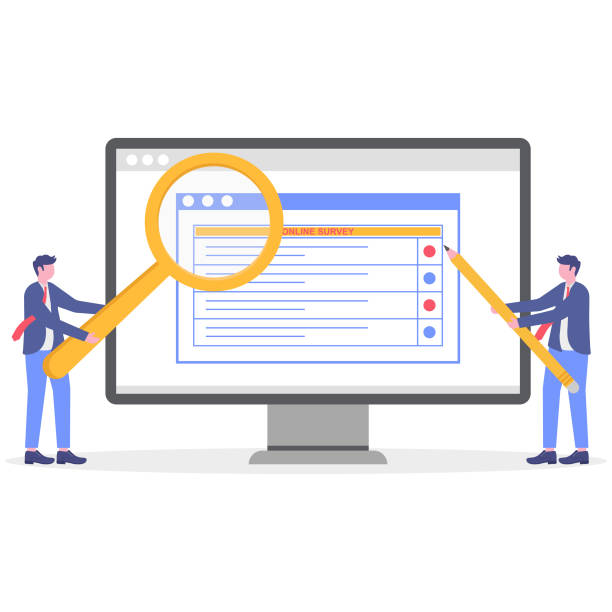Introduction to the Importance of Secure Website Design and Common Cyber Threats

In today’s digital world, where businesses and personal information are increasingly moving online, #حفاظت_از_دادهها (data protection) and #امنیت_سایبری (cybersecurity) are of vital importance.
Secure website design is no longer a luxury option, but an undeniable necessity.
Every day, we witness news related to cyber attacks, information theft, and breaches into online systems that can cause irreparable financial and reputational damage.
From simple phishing attacks to complex DDoS attacks and ransomware, cyber threats are evolving and require a comprehensive and preventive approach in the website development process.
This chapter provides a comprehensive introduction to the reasons for the importance of website security, as well as an overview of the most common security threats that any website may face.
Understanding these threats is the first step towards creating an impenetrable website.
This section is educational and helps you identify potential risks and realize the profound importance of cybersecurity in website design.
Are you worried about your online store’s low conversion rate and not achieving your desired sales?
Rasawweb is your specialized solution for having a successful online store.
✅ Significant increase in conversion rates and sales
✅ Professional and user-friendly design to attract customer satisfaction
⚡ Ready for a transformation in online sales? Get a free consultation!
Key Principles of Secure Website Design from an Architecture and Coding Perspective

To ensure secure website design, adhering to the principles of #معماری_امن (secure architecture) and #کدنویسی_امن (secure coding) from the very early stages of development is crucial.
These principles involve approaches that minimize vulnerabilities at the code and system design levels.
One of the most important principles is the “Principle of Least Privilege”, which means granting the minimum necessary access rights to users and processes to perform their tasks.
This approach reduces the risk of penetration and damage if a user account or process is compromised.
Additionally, #تفکیک_مسئولیتها (separation of duties) and the use of modular architecture can help identify and isolate weaknesses.
In the coding section, #اعتبارسنجی_دادههای_ورودی (Input Validation) is a fundamental principle.
All user inputs must be carefully checked and sanitized to prevent attacks such as SQL injection or XSS (Cross-Site Scripting).
Following secure development principles and reliable coding standards, such as OWASP (Open Web Application Security Project) recommendations, helps developers produce robust and attack-resistant code.
Using secure frameworks and libraries, regularly updating them, and performing code reviews are other important aspects in this specialized field.
Choosing a Secure Platform and Hosting for Your Website

Choosing the right #هاستینگ_امن (secure hosting) and #پلتفرم_مطمئن (reliable platform) is the first step and one of the most important decisions for secure website design.
A reputable hosting provider offers strong security infrastructures such as advanced firewalls, intrusion detection and prevention systems (IDS/IPS), regular backups, and 24/7 monitoring.
These features can protect your website against many common attacks.
Also, selecting a website development platform (such as WordPress, Joomla, Drupal, or web development frameworks) that has an active user community, regular security updates, and strong support is crucial.
Popular platforms are often targets for more attacks, but simultaneously have a large community of developers for discovering and fixing vulnerabilities.
In contrast, less-known platforms might be attacked less often, but if a weakness is discovered, support and remediation can be more difficult.
These decisions form the foundation of a robust website.
Below is a table comparing common security features in secure hosting services:
| Security Feature | Description | Importance in Website Security |
|---|---|---|
| Software and Hardware Firewall (WAF) | Protective systems that filter malicious traffic. | Protection against known attacks like SQL Injection and XSS. |
| Regular Backup and Recovery | Creating copies of data and enabling quick restoration in case of issues. | Reducing downtime and data loss after an attack. |
| Free or Easy SSL/TLS Certificate | Encrypting data between the user and the server. | Ensuring data confidentiality and integrity and increasing user trust. |
| Intrusion Detection and Prevention Systems (IDS/IPS) | Monitoring traffic to identify and block suspicious activities. | Active defense against intrusion attempts. |
| Automatic Server and Platform Updates | Applying security patches and updating server software. | Fixing known vulnerabilities as soon as possible. |
| 24/7 Monitoring and Alerting | Continuous monitoring of security status and sending alerts in case of an event. | Rapid response to security threats. |
Database Security and Preventing SQL Injection

The database is the heart of every website, containing critical user and business information.
Therefore, ensuring #پایگاه_داده_امن (secure database) and #حفاظت_اطلاعات (data protection) plays a vital role in secure website design.
One of the most common and dangerous attacks on databases is #تزریق_SQL (SQL injection).
This attack occurs when attackers inject malicious SQL code through user inputs (such as search or login forms) into the website and execute their desired SQL commands in the database.
This can lead to the disclosure of sensitive information, alteration or deletion of data, and even full control over the database server.
To prevent this attack, the use of #Prepared_Statements or #Parameterized_Queries in coding is essential.
These methods ensure that user inputs are interpreted as data, not executable code.
Additionally, using least privileges for database user accounts, encrypting sensitive information in the database, regularly updating the Database Management System (DBMS), and using a Database Firewall are other key measures to ensure overall system security.
This specialized topic requires a deep understanding of how a website interacts with its database.
Did you know that 94% of users’ first impression of a business is related to its website design? With professional corporate website design by **Rasawweb**, turn this first impression into an opportunity for growth.
✅ Attract more customers and increase sales
✅ Build credibility and trust in the audience’s eyes⚡ Get a free website design consultation!
Authentication and Access Control Management in Secure Website Design

Proper management of #احراز_هویت (Authentication) and #کنترل_دسترسی (Access Control) forms the backbone of any efficient security system in secure website design.
Authentication refers to the process of verifying a user’s identity (e.g., with a username and password), while access control determines which resources a user can access after authentication.
Weaknesses in either of these two areas can open the door for attackers.
Using strong passwords and mandatory policies for regular password changes are basic principles.
Implementing #احراز_هویت_دومرحلهای (2FA) or #چندمرحلهای (MFA) provides a powerful security layer, because even if a password is leaked, an attacker cannot log in without the second authentication factor.
For access control, Role-Based Access Control (RBAC) models are recommended, where access is granted to users based on predefined roles (e.g., administrator, editor, regular user).
This approach reduces the complexity of access management and minimizes human errors.
Furthermore, limiting the number of unsuccessful login attempts, using CAPTCHA to prevent Brute Force attacks, and logging and monitoring authentication activities are other specialized measures that help strengthen this critical aspect of an efficient security system.
The Role of SSL/TLS Certificates and HTTPS Protocol in Web Security

In the current era, the use of #SSL/TLS certificates and the #HTTPS protocol is a golden and fundamental standard in secure website design and ensuring #رمزنگاری_دادهها (data encryption).
SSL (Secure Sockets Layer) and its successor TLS (Transport Layer Security) are protocols that encrypt communication between the user’s browser and the website server.
This encryption prevents eavesdropping, data tampering, and identity spoofing during transmission.
When a website uses HTTPS (HTTP Secure), it means that its communication is encrypted via SSL/TLS, and browsers usually inform the user of this by displaying a green padlock next to the web address.
This not only guarantees the security of sensitive information such as bank card details or passwords but also builds #اعتماد_کاربران (user trust), as users know that their information is protected during transmission.
Furthermore, search engines like Google prioritize websites with HTTPS, and this can positively affect the website’s SEO ranking.
Implementing an SSL/TLS certificate is an essential and explanatory step towards creating secure internet communications and complying with current security standards.
Continuous Website Updates and Maintenance for Security

Secure website design is not a one-time process, but requires #نگهداری_سایت (website maintenance) and #بهروزرسانی_مداوم (continuous updates) to withstand evolving threats.
Attackers are constantly looking for new vulnerabilities in software, plugins, themes, and even server operating systems.
Therefore, regularly applying security patches and updating all website components, including the platform core (e.g., WordPress, Joomla), plugins, themes, and even server-side software (e.g., PHP, MySQL), is of paramount importance.
Many successful cyber attacks result from negligence in updating software with known vulnerabilities.
In addition to updates, continuous monitoring of server logs to identify suspicious activities, regular website scans for malware and vulnerabilities, and preparing regular and recoverable backups are among the vital measures in #امنیت_پویا (dynamic security).
This approach is a #رویکرد_پیشگیرانه (preventive approach) and ensures that your website is always in the best security state.
This section provides informative news about the importance of dynamic security and the necessary actions for it.
Below is a table for a security maintenance checklist:
| Action | Description | Recommended Frequency |
|---|---|---|
| Update Platform Core (CMS) | Ensure the latest security versions and new features are installed. | Immediately upon release of a new version/security patch |
| Update Plugins and Themes | Address potential vulnerabilities in plugins and themes. | Immediately upon release of a new version/security patch |
| Regular Malware and Vulnerability Scan | Use scanning tools to identify malicious code or weaknesses. | Weekly/Monthly |
| Backup Entire Website (Files and Database) | Store recoverable copies of all content and data. | Daily/Weekly (depending on content change rate) |
| Review Server and Security Logs | Monitor for unusual activities or intrusion attempts. | Daily/Weekly |
| Review User Access and Roles | Ensure each user has only the necessary access. | Monthly/After personnel changes |
| Change Important Passwords | Update admin and database passwords. | Every 3 to 6 months |
Penetration Testing and Web Security Scanners

To ensure the effectiveness of security measures and #طراحی_سایت_امن (secure website design), performing #آزمونهای_نفوذپذیری (Penetration Testing) and using #اسکنرهای_امنیتی_وب (web security scanners) is essential.
Penetration testing is a simulated and controlled attack on a website, carried out by security specialists (ethical hackers) to identify vulnerabilities before real attackers find them.
This process involves attempting to bypass security systems, gain unauthorized access to data, and exploit known and unknown weaknesses.
The results of penetration testing provide a comprehensive report of weaknesses, how to exploit them, and recommendations for remediation.
Alongside manual penetration testing, automated security scanners are also valuable tools.
These scanners can quickly examine a website to identify known vulnerabilities, configuration errors, and the presence of malware.
Using a combination of both methods (manual penetration testing and automated scanners) helps you gain a comprehensive picture of your website’s security status and ensure there are no hidden or new weaknesses.
This analytical and specialized process plays a key role in #کشف_آسیبپذیریها (vulnerability discovery) and significantly contributes to the website’s defensive strength.
Are you tired of your online store having visitors but no sales? Rasawweb solves your main problem with professional online store designs!
✅ Significant increase in sales with targeted design
✅ Flawless user experience for your customers
⚡ Get a free consultation!
Responding to Security Incidents and Planning for Data Recovery

Even with the best #طراحی_سایت_امن (secure website design) and preventive approaches, no website is completely immune to attacks.
Therefore, having a well-defined #پاسخ_به_حوادث_امنیتی (Incident Response Plan) and #برنامه_بازیابی_اطلاعات (Disaster Recovery Plan) is an integral part of a comprehensive security strategy.
The incident response plan includes steps to be taken immediately after identifying an attack or breach; including identification, containment, eradication, recovery, and learning from the incident.
This plan should include clear responsibilities for each team or individual, necessary tools for incident analysis, and communication protocols.
The main goal is to minimize damage, reduce downtime, and restore the system to normal operation as quickly as possible.
The disaster recovery plan also allows you to quickly recover your website with minimal data loss if information is lost or damaged (due to a cyber attack, hardware failure, or natural disasters).
This includes regular backups, storing them in secure and remote locations, and testing the recovery process.
Having these plans is a specialized approach and guidance for #مدیریت_بحران (crisis management) in the digital world.
The Future of Secure Website Design and New Trends in Cybersecurity

The world of cybersecurity, and consequently secure website design, is constantly evolving and advancing.
Attackers with new tools and methods, and defenders with novel technologies to counter them, are in a continuous competition.
In the future, we will witness an increased use of #هوش_مصنوعی (Artificial Intelligence – AI) and #یادگیری_ماشین (Machine Learning – ML) in detecting and preventing threats.
These technologies can identify suspicious traffic patterns with greater accuracy and automatically respond to attacks.
Additionally, #بلاکچین (blockchain) and Distributed Ledger Technologies (DLT) may play an important role in strengthening data security and authentication, by providing transparent and immutable systems for recording transactions and validating identities.
#Zero_Trust architectures, which are based on the principle that no user or device, whether inside or outside the network, is trustworthy unless its identity and access are continuously verified, will also become increasingly popular.
With the growing use of Internet of Things (IoT) devices and increased reliance on cloud services, new challenges will also emerge in the field of website security.
Understanding these trends and being prepared to adapt to them helps developers and website managers stay one step ahead of threats and build engaging yet completely secure websites.
This section is an entertaining analysis of the future of this field.
Frequently Asked Questions
| Question | Answer |
|---|---|
| What is secure website design? | Secure website design is a process in which websites are built with security principles in mind to be resistant to cyber attacks and to protect user and business information. |
| Why is secure website design of high importance? | To prevent unauthorized data access, sensitive information leakage, malware attacks, loss of user trust, damage to business reputation, and legal consequences resulting from data breaches. |
| What are the most common website vulnerabilities? | SQL Injection, Cross-Site Scripting (XSS), Cross-Site Request Forgery (CSRF), broken authentication and session management, and sensitive data exposure. |
| How can SQL injection attacks be prevented? | Use of Prepared Statements with parameterized queries, Input Validation, and limiting database access. |
| What are the methods to counter XSS (Cross-Site Scripting) attacks? | User input validation, output encoding before displaying in HTML, and using Content Security Policy (CSP). |
| What is the role of HTTPS in website security? | HTTPS encrypts communication between the user’s browser and the website server using an SSL/TLS certificate, preventing eavesdropping, tampering, or spoofing of data. |
| What are the best practices for managing user passwords? | Enforcing strong passwords (a combination of letters, numbers, and symbols), hashing passwords instead of storing them directly (with strong algorithms like bcrypt), and enabling two-factor authentication (2FA). |
| What is the importance of User Input Validation? | Input validation prevents malicious or unexpected data from entering the system, which can lead to vulnerabilities such as SQL Injection or XSS. |
| What is the impact of regular security reviews and audits on site security? | These reviews help identify vulnerabilities and security weaknesses early, allowing them to be addressed before they can be exploited. |
| What is the application of Web Application Firewall (WAF) in secure website design? | A WAF acts as a protective layer between the user and the website, analyzing incoming traffic, identifying, and blocking common web attacks like SQL Injection and XSS. |
And other services of Rasawweb Advertising Agency in the field of advertising
Smart Digital Branding: A novel service for increasing customer attraction through custom programming.
Smart Custom Software: A fast and efficient solution for increasing website traffic with a focus on optimizing key pages.
Smart Direct Marketing: An effective tool for campaign management with the help of custom programming.
Smart Data Analysis: A fast and efficient solution for digital branding focusing on attractive UI design.
Smart Custom Software: A combination of creativity and technology for digital branding by customizing the user experience.
And over hundreds of other services in the field of internet advertising, advertising consultation, and organizational solutions
Internet Advertising | Advertising Strategy | Advertorial
Resources
Comprehensive Website Security Guide
Data Protection in the Digital World
Web Design Security Articles
Website Security and SSL Certificate
📍 In the fast-paced world of digital, Rasawweb Afarin Digital Marketing Agency, with its expertise and experience, is the guide to your business’s success. From personal website design to comprehensive digital campaigns, we are by your side to ensure a powerful and impactful online presence.
📍 Tehran, Mirdamad Street, next to Bank Markazi, Southern Kazeroon Alley, Ramin Alley, No. 6


